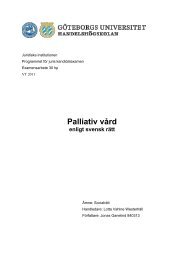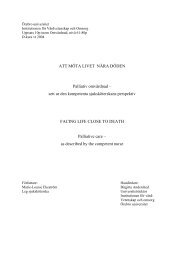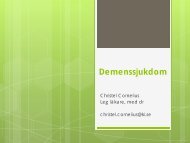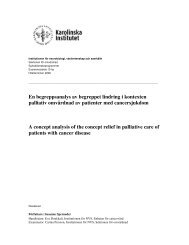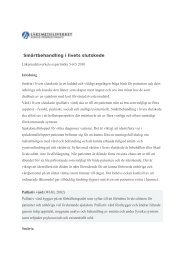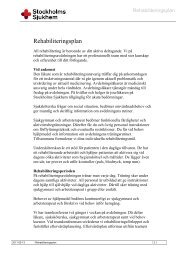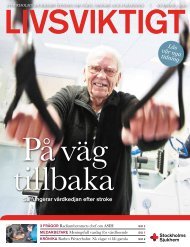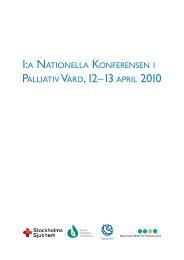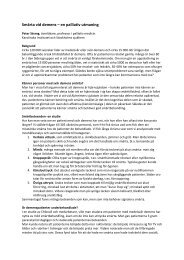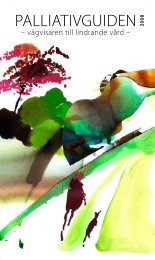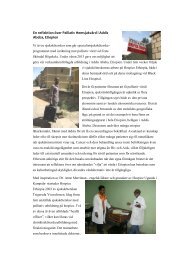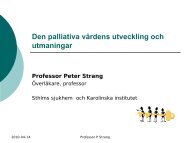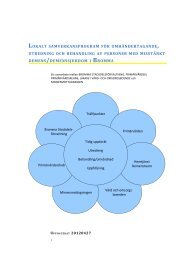Physiotherapy in palliative careâ - Stockholms sjukhem
Physiotherapy in palliative careâ - Stockholms sjukhem
Physiotherapy in palliative careâ - Stockholms sjukhem
You also want an ePaper? Increase the reach of your titles
YUMPU automatically turns print PDFs into web optimized ePapers that Google loves.
Massage and relax<strong>in</strong>g techniquesMassage is def<strong>in</strong>ed as treatment of the body’s soft tissues carried out manually with the aim ofgett<strong>in</strong>g a vascular, muscular as well as a nervous system response. (28) Massage is one of theoldest known forms of heal<strong>in</strong>g that goes back 5000 years <strong>in</strong> Ch<strong>in</strong>a and has many positive bothphysical and psychological effects. Touch<strong>in</strong>g <strong>in</strong> connection with massage sets the body’s ownsubstances e.g. oxytoc<strong>in</strong> and seroton<strong>in</strong> free. They have a calm<strong>in</strong>g effect and reduce pa<strong>in</strong>.Relax<strong>in</strong>g techniques are often given under the guidance of a physiotherapist or <strong>in</strong> the form of ataped program. The program <strong>in</strong>forms the patient on how the relaxation can be carried out andthe patients can handle this program by themselves. Both massage and treatment with relaxationcan be given <strong>in</strong> order to reduce tensions of the muscles which have occurred due to pa<strong>in</strong>. (29)Assessment:In what stage of the disease is the patient?Has the patient pa<strong>in</strong> when palpated?Is the sk<strong>in</strong> frail?What can the patient psychologically accept?Treatment:Many patients <strong>in</strong> a late <strong>palliative</strong> phase of the disease have reduced muscle mass and frail sk<strong>in</strong>because the prote<strong>in</strong> destruction and corticosteroids. This makes a lighter massage more suitablefor these patients. In many <strong>palliative</strong> care units a light touch<strong>in</strong>g massage, tactile massage or softmassage is used rather than manipulat<strong>in</strong>g the soft tissues.Massage can be given dur<strong>in</strong>g all phases of the disease. Massage gives relief dur<strong>in</strong>g andimmediately after treatment. (11)Different relax<strong>in</strong>g techniques like progressive relaxation and autogenic exercise ly<strong>in</strong>g down orsitt<strong>in</strong>g as well as us<strong>in</strong>g a float<strong>in</strong>g device <strong>in</strong> the water can help people relax.Studies show that massage as pa<strong>in</strong> relief can work for a short while for cancer patients. (28, 30,31) There is not enough evidence to make conclusion about the effect of massage compared toother treatment alternatives. (26) There is also contradictory evidence that relaxation helps withendur<strong>in</strong>g pa<strong>in</strong>. There is also not sufficient knowledge about the effect with relaxation withneck- shoulder- pa<strong>in</strong>, rheumatic arthritis, myalgia or head ache. (26)<strong>Physiotherapy</strong> <strong>in</strong> <strong>palliative</strong> care – a cl<strong>in</strong>ical handbook Ulla Frymark, Lilian Hallgren, Ann‐Charlotte Reisberg 22



